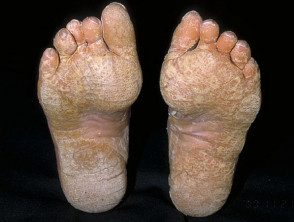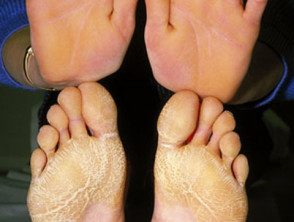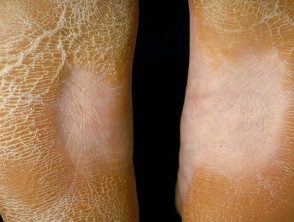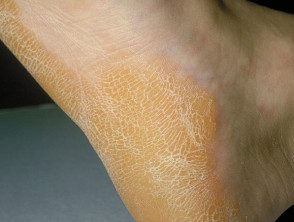What are they diffuse hereditary palmoplantar keratodermas?
Diffuse hereditary palmoplantar keratodermas are palmoplantar keratodermas that affect most palms and soles and are caused by a genetic anomaly. Various family members can be affected. Some types of keratoderma they are associated with abnormalities of internal organs.
They can be inherited from an affected parent (known as autosomal dominant inheritance) or from both parents, who are generally unaffected (known as autosomal recessive heritage). The affected gene it has been specifically identified for many of these keratodermas.
What are the clinical features of diffuse hereditary palmoplantar keratodermas?
Diffuse hereditary palmoplantar keratodermas present in early childhood with redness of the palms and soles of the feet. The palms and soles gradually thicken and develop a yellowish, waxy appearance. There is a clear boundary between affected and unaffected skin and the border of the thickening is often red. This is usually obvious by the age of 3 to 4.
Increased sweating (hyperhidrosis) is quite common and there is a tendency to fungus and bacterial foot infections.
Diffuse hereditary palmoplantar keratoderma

Diffuse palmoplantar keratoderma

Diffuse palmoplantar keratoderma

Diffuse palmoplantar keratoderma
"Transgradient" is a term used to describe the extent of thickening of the skin:
- Non-transgraducing keratodermas do not extend beyond the palms of the hands and the soles of the feet. They can affect the knuckle pads and nail but don't involve the thin skin on the tops of the feet or hands.
- Transgradient keratodermas extend beyond the palms and soles to the back of the hands and feet and, in some cases, to the wrists and ankles. The skin around the mouth, eyes, nose, and over the elbows and knees can also be affected.
Diffuse non-transgradient palmoplantar keratodermas
Non-transgradient diffuse hereditary keratodermas are known as Vorner disease and Unna-Thost disease. They are inherited as autosomal dominant conditions There are no associated abnormalities. They look the same but have slightly different findings on the skin biopsy.
Unna-Thost palmoplantar quenaderma

Diffuse palmoplantar keratoderma

Diffuse palmoplantar keratoderma

Diffuse palmoplantar keratoderma
Diffuse transgradient palmoplantar keratodermas
| Olmsted syndrome |
|
| Mal de Meleda |
|
| Huriez syndrome |
|
Diffuse palmoplantar keratoderma associated with other abnormalities
Deafness
- Vohwinkel syndrome is an autosomal dominant keratoderma associated with a thickening in the shape of a “starfish” over the knuckles, forming tight bands around the fingers that sometimes result in amputation of the affected finger or toe (pseudoainhum) and deafness. .
- Loricrin keratoderma is a variant of Vohwinkel syndrome that also produces dry, flaky skin over the rest of the body (ichthyosis)
- Bart-Pumphrey syndrome is an autosomal dominant keratoderma, similar to Vohwinkel syndrome, with thickened knuckles, white nails, and deafness.
- Diffuse palmoplantar keratoderma with deafness is due to a mutation in mitochondria (inherited by a different method than autosomal dominant or recessive patterns).
Hair, nail and tooth abnormalities
- Hydrotic ectodermal dysplasia is an autosomal dominant keratoderma associated with very sparse or absent hair on the head, face, and body and short, thickened nails that are easily lost. The thickening of the skin can also affect the knuckles, knees, and elbows.
- Papillon-Lefevre syndrome is an autosomal recessive keratoderma associated with inflammation gum and tooth loss, thinning hair and recurrent Bacterial infections of the skin and internal organs.
- Diffuse PPK with woolly and arrhythmogenic hair cardiomyopathy is an autosomal recessive condition associated with congenital heart disease and thick, unruly hair.
What is the treatment of diffuse palmoplantar keratodermas?
The following treatments soften thickened skin and make it less noticeable.
- Emollients
- Keratolytic agents (eg, salicylic acid 6% in propylene glycol 70%)
- Current retinoids
- Topical vitamin D ointment (calcipotriol)
Oral retinoids (acitretin)
Which is the forecast for diffuse palmoplantar keratodermas?
Diffuse plamoplantar keratodermas persist for life and can be passed on to the next generation.

